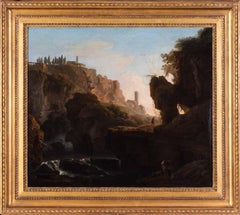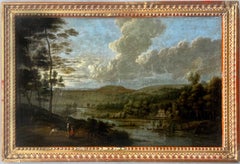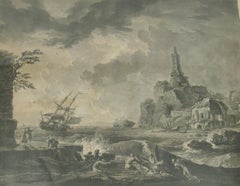Claude Joseph Vernet Art
to
1
1
1
1
Overall Height
to
Overall Width
to
1
1
1
1
1
1
1
6,996
3,377
2,513
1,212
1
1
1
1
Artist: Claude-Joseph Vernet
Claude-Joseph Vernet 18th century Old Master landscape, grand tour Italy
By Claude-Joseph Vernet
Located in Petworth, West Sussex
Claude-Joseph Vernet (French, 1714 – 1789)
Fisherman by a cascade in a gorge
Oil on canvas
22.1/4 x 25.1/2 in. (56.5 x 64.7 cm.)
Provenance:
The estate of the late Betty, Lady Grantchester
Du Catalogue Collection #39
Christie's London, 3 Dec 1997, Lot 52 (£41,000)
Claude-Joseph Vernet was the leading French landscape painter (with Hubert Robert) of the later 18th century. He achieved great celebrity with his topographical paintings and serene landscapes. He was also one of the century's most accomplished painters of tempests and moonlight scenes...
Category
18th Century Old Masters Claude Joseph Vernet Art
Materials
Oil, Canvas
Related Items
17th century Flemish Old Master painting - Countryside landscape - Rubens
Located in Antwerp, BE
17th century Flemish old master painting depicting a peaceful countryside scenery by Lucas Van Uden
Lucas Van Uden's life unfolded against the backdrop of the rich artistic tapestry...
Category
17th Century Old Masters Claude Joseph Vernet Art
Materials
Oil, Canvas
The Knight - painting - XVII century
Located in Roma, IT
The Knight is an original oil painting on canvas realized during the XVII century by an anonymous artist.
Provenance: Pecci-Blunt collection. Good condition...
Category
17th Century Old Masters Claude Joseph Vernet Art
Materials
Canvas, Oil
Large 18th Century British Old Master Oil Painting Figures at Dusk in Woodland
Located in Cirencester, Gloucestershire
The Close of Day
English artist, second half 18th century
circle of Thomas Gainsborough (British 1727-1788)
oil on canvas, unframed
canvas: 24.5 x 29 inches
provenance: private colle...
Category
18th Century Old Masters Claude Joseph Vernet Art
Materials
Oil, Canvas
18th Century sporting horse portrait oil painting of a race horse and groom
By Francis Sartorius
Located in Nr Broadway, Worcestershire
Francis Sartorius
British, (1734-1804)
Bay Hunter & Groom
Oil on canvas, signed
Image size: 24.25 inches x 29.25 inches
Size including frame: 32 inches x 37 inches
A wonderful spor...
Category
18th Century Old Masters Claude Joseph Vernet Art
Materials
Oil, Canvas
Allegory of four elements, pupil of Jan Brueghel the Younger (1601-1678)
Located in PARIS, FR
17th century Antwerp school
Landscape, animals and stilllife by a pupil of Jan Brueghel the Younger (1601-1678)
Figures by a pupil of Frans Francken II
Oil on canvas: h. 52,5 cm, w. ...
Category
Mid-17th Century Old Masters Claude Joseph Vernet Art
Materials
Canvas, Oil
Peasants in a Cornfield (Boer in het veld) by David Teniers the Younger
By David Teniers the Younger
Located in Stockholm, SE
Remembering the magic of everyday life moments in the art of David Teniers:
The art of David Teniers the Younger (1610–1690) coincided with the heyday of the Flemish Baroque and captured a great variety of motifs of his time. In this painting of a seemingly simple peasant scene lies keys to understanding both the imaginative mind of Teniers as well as why this time period produced some of the most iconic works in all of art history.
As indicated by the name, Teniers was more or less born into his profession. As the son of David Teniers the elder, himself a painter who studied under Rubens, the younger David received training in art from a very young age and had no less than three brothers who also became painters. Because of his father’s frequent financial failures that even at times saw him imprisoned, David the younger helped to rescue the family from ruin through painting copies of old masters. Essentially, the young Teniers was confronted with painting as both a passion and creative expression as well as a necessity during difficult times, an experience that would shape much of his capacity and sensitivity in his coming life.
Despite the hardships, the talent and determination of Teniers was recognized and quickly expanded his possibilities. He had already spent time in France and possibly also England when he was hired by his father’s former teacher Rubens to help with a prestigious commission with mythological paintings, now considered lost, for Philip IV the king Spain. In 1644–54 Teniers was appointed dean of the Antwerp Guild of Saint Luke, manifesting his esteemed position within the artistic community. A few years afterwards he took an important step when relocating to Brussels, where Teniers yet again found new career opportunities that would prove to be very successful.
As the keeper of the collections of Archduke Leopold Wilhelm, a role similar to what we now refer to as an art advisor, Teniers purchased hundreds of important artworks that manifested the prominent status of the Archduke’s collection while at the same time providing an unusual access to inspiration and knowledge for Teniers himself. Since he kept on painting during the same time, his creative scope must have seemed almost bewildering in the great variety of images and stories that he surrounded himself with.
Regardless of how glamorous and culturally stimulating the career of Teniers was, he was as open to the charm and existential importance of everyday life as he was to works of great masters and luxurious collectibles. In his impressive repertoire of genres with everything from exquisite royal portraits, interiors, landscapes and history paintings he always added something new and inventive, highlighting the possibilities of art and importance of an experimental and intuitive mind. It is difficult to single out one aspect or genre to summarize his legacy, since it lies much more in the broad virtuosity across many motifs, although he is particularly remembered for farm scenes and meticulously depicted interiors where other paintings and artworks are captured with an astonishing precision. However, the fact that he is still today one of the most known and celebrated names of the Dutch Golden Age is a proof to the magic of his work, which continues to spark dialogue and wonder in the contemporary viewer of his works.
The farm boy in the field in this painting, which likely dates to the mature part of his career, is a wonderful entry into the mind of Teniers. In the tightly cropped motif, we see him standing right in the middle of the busy harvest when men, women and everyone capable were sent out in the field to collect the crop that formed the very core of their diet and survival. In the background we see a fresh blue sky interspersed with skillfully painted clouds, some trees reaching their autumnal colours and in the far distance the glimpse of a small church and village. The presence of a church in a landscape, so typical of Dutch art, served both a symbolic and visual function as a representation of faith while at the same time defining scale and distance.
In the field, the work is in full action with the farmers spread out in various positions, all in the midst of hard and sweaty labour. While they are portrayed as having nothing else than the work on their mind, our farm boy seems to have his attention directed elsewhere. Standing there with his white, half open shirt, flowy curls and strong, sturdy body; his gaze is directed away, out of the picture and the scythes in his hands. He looks almost smirking, expressed with tremendous subtlety in the slight smile of his lips and big eyes, being just in the middle of losing focus on the work. What is it that steals his attention? What has he seen, or realized, or felt – to break him free of the arduous task of harvesting, if but for a moment?
Here starts the wondering and the questions that are the hallmark of a great piece of art. Instead of explicitly locking in the motif in overly clear symbolism Teniers has chosen an open ended, subtle yet striking moment for us to consider. While it of course can be related to numerous other farm scene depictions of this time, and clever usages of gazes and real-life scenes to underscore various moral or symbolic meanings, the painting can be much more of a contemplation than an explanation or illustration. The ordinary nature and understated yet emotionally textured composition of the motif gives greater space for our own reactions and thoughts. Has he seen a pretty farm girl just passing by? Is he fed up with the farm life, joyously dreaming away for a minute, imagining another future? Or is he simply in need of distraction, looking away and ready for anything that can steal his attention?
One quality that never seem to have escaped Teniers was that of curiosity. During all of his career he constantly investigated, expanded and experimented with not only the style and technique of painting, but with the vision of art itself. Being credited with more or less introducing farm motifs for a broader audience not only tells us of his ability to understand the demand for different motifs, but the sensitivity to transform seemingly ordinary parts of life into deep aesthetic experiences, far beyond their expected reach. The farm boy in this painting is, of course, exactly that. But with the help of one smirk the entire picture is charged with a different energy, awakening many contrasts and relationships between the calm landscape, the hard work and his own breach of effectivity, holding sharp scythes while thinking or seeing something else.
It is no wonder Teniers chose to work with farm scenes as a way of investigating these intricate and delicate plays on expectations and surprises, clarity and ambivalence. It invites us to an appreciation of human everyday life that connects us with the people of 17th century...
Category
Late 17th Century Old Masters Claude Joseph Vernet Art
Materials
Oil, Canvas
Free Shipping
H 12.6 in W 10.04 in
Large 17th century religious family painting - Mary with Christ and Anna
Located in Antwerp, BE
17th century Old Master painting depicting the Infant Christ with Mary and St. Anne attributed to Nicolas de Liemaker
The artist of the present work wonderfully captured the loving gaze of Maria, looking in awe at her child. One can sense the tenderness and love in her eyes. The eyes of Christ appears to be filled with wisdom and love and a finely painted aura crowns his and his mother's heads. St. Anne, Mary's mother, gently holds the infant whilst gazing adoringly at him. The painting is not only a beautiful depiction of Christ and his mother and grandmother, but also a sweet image of the tender bond between a mother's and their children. The vibrant and soft colours of the fabric create a soft cocoon around the figures and seem to further emphasis the beauty and importance of the depicted scenery and its protagonists.
Nicolaas de Liemaecker (also spelled as Liemaker or Liemackere) was a Flemish painter born in Ghent in 1601. He was also known under the name Nicolaas Roose. His father was Jacobus de Liemaecker, a painter upon glass. Nicolaas is reported to have been trained by his father and Gaspard de Crayer II (1), an apprenticeship with Otto Van Veen has also been suggested. In 1624 he worked at the Court of the Bishop of Paderborn and for Ferdinand of Bavaria. He later returned to his native city, where he focused on religious and historical paintings. He was a very accomplished and celebrated artist who attained a high rank in his profession. He witnessed the baptisms of Pieter and Janne-Marie Van Hulle...
Category
17th Century Old Masters Claude Joseph Vernet Art
Materials
Canvas, Oil
River Landscape Village Paint oil on canvas 17th Century
Located in Riva del Garda, IT
River landscape with popular life scene
Oil painting on canvas
62 x 98
Framed 74 x 110 cm.
We present this vast and harmonious composition, where a characteristic river landscape acts as a stage for an exquisite extract of popular life, set in a small village on the edge of a lush stream.
The painting, which presents characters unequivocally linked to the Flemish culture of the second half of the 17th century, shows iconographic and stylistic correspondences, in particular, with the successful production of Adrien Frans Boudewijns (1644-1711) and Pieter Bout (1658- 1719).
Aside from the figure of duck hunter...
Category
17th Century Old Masters Claude Joseph Vernet Art
Materials
Oil, Canvas
Huge 19th Century Italian Classical Still Life Ornamental Birds Fruit & Flowers
Located in Cirencester, Gloucestershire
Ornamental Still Life with fruit, flowers and birds
Italian School, 19th century
oil painting on canvas, unframed
size: 31.5 x 47 inches
condition: relined canvas and in very good and presentable condition
provenance: from a collection here in England.
A very beautiful and decorative oil painting on a huge scale, depicting this classical landscape scene, with ornamental birds...
Category
19th Century Old Masters Claude Joseph Vernet Art
Materials
Oil, Canvas
Attributed to John Riley, 17th century English portrait of a girl on a terrace
By John Riley
Located in Bath, Somerset
Portrait of a young girl, full-length, wearing a blue silk gown, standing on a terrace beside a classical urn holding a branch with blossom. Attributed to John Riley...
Category
17th Century Old Masters Claude Joseph Vernet Art
Materials
Oil, Canvas
A pair of 18th century Italian landscapes with classical ruins and figures
By Giovanni Paolo Panini
Located in Bath, Somerset
A pair of 18th century Italian landscapes with classical ruins and figures, circa 1750.
Circle of Giovanni Panini (1691-1765)
Thomas Agnew and Sons, Lo...
Category
18th Century Old Masters Claude Joseph Vernet Art
Materials
Canvas, Oil
View of Ponte Milvio in Rome
Located in Roma, RM
Northern painter active in Rome in the second half of the 17th century, View of Ponte Milvio
Oil painting on canvas 73 x 97 cm in coeval Roman Salvator Rosa frame.
Category
18th Century and Earlier Old Masters Claude Joseph Vernet Art
Materials
Canvas, Oil
Previously Available Items
Costal Harbour Landscape with a Ship and brewing Storm - 18th Century Engraving
By Claude-Joseph Vernet
Located in Meinisberg, CH
Claude - Joseph Vernet
(French, 1714-1789)
Costal Harbour Landscape with a Ship under a brewing Storm
Engraving
Visible image, ca. 47.5 x 59 cm
Plate size, ca. 46.5 x 56 cm
Frame, ca. 56 x 66 cm
Plate signed
Large formatted engraving, after a painting by this very well well know french artist. C.-J. Vernet would have been involved in the production of this sheet. The image was engraved by anglo-scotish engraver Robert Laurie (c. 1755–1836) and published in London, 1773.
Vernet was born 14th of August, 1714 in Avignon. At the age of 14 he began helping his father, who decorated panels of then widely used sedan chairs. Soon the young artist left France for Rom, Italy. and immediately after his arrival he entered the studios of whale painter Bernardino Fergioni and marine landscapist Adrien Manglard.
1734 he returned to France and studied the work of various forerunners such as Claude Gelee (Claude Loraine). I had great interest observation of natural effects of atmosphere, which he rendered with unusual pictorial art. Note how he masterly depicted the weather on this engraving on offer.
Vernet was productive up to his death 3rd of December 1783, with numerous exhibitions and royal commissions.
Claude-Josephs paintings are held in many important museums internationally and the list of noted engravers who reproduced his popular work is long.
The previous owner framed the 18th century engraving in a luxurious, handmade, gold leafed, flat molded frame about 50 years ago. The sheet is mounted behind an antique...
Category
18th Century Naturalistic Claude Joseph Vernet Art
Materials
Paper, Ink, Engraving
Free Shipping
H 22.05 in W 25.99 in D 0.79 in
Claude-joseph Vernet art for sale on 1stDibs.
Find a wide variety of authentic Claude-Joseph Vernet art available for sale on 1stDibs. You can also browse by medium to find art by Claude-Joseph Vernet in canvas, fabric, oil paint and more. Much of the original work by this artist or collective was created during the 18th century and is mostly associated with the Old Masters style. Not every interior allows for large Claude-Joseph Vernet art, so small editions measuring 26 inches across are available. Customers who are interested in this artist might also find the work of Jan Frans van Bloemen (Orizzonte), George Morland, and Jean-Baptiste Monnoyer. Claude-Joseph Vernet art prices can differ depending upon medium, time period and other attributes. On 1stDibs, the price for these items starts at $67,224 and tops out at $67,224, while the average work can sell for $67,224.



